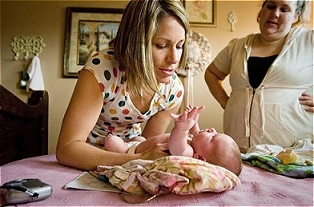|
Homebirth Is As Safe As Hospital Birth
The US Department of
Health and Human Services on August 31, 2009 and USA Today on Septmeber
3, 2009 each featured the following
article which refers to
the recent
study by CMAJ, (Canadian Medical
Association Journal) The world is listening!

Becky Orchard, a midwife in training and a certified doula, does a
check-up on 3-week-old Cody Drake
as his mother, Kelly Routt, watches at Dayspring Midwifery Services in
Hayden, Idaho. - USA Today
Home Birth With
Midwife As Safe As Hospital Birth: Study
Canadian researchers find lower rate of complications.
By Amanda Gardner
"Outcomes of planned home birth with registered midwife
versus planned hospital birth with midwife or physician".
MONDAY, Aug. 31 Having your baby at home with a registered
midwife is just as safe as a conventional hospital birth, a new
study says.
In fact, planned home births of this kind may have a lower rate of
complications, according to the study published in the Sept. 15
issue of CMAJ.
Even though the study was conducted in Canada, where attitudes
toward midwifery are more accepting than in some other countries,
the findings may help to calm an ongoing controversy in the United
States and elsewhere.
The American College of Obstetricians and Gynecologists is opposed
to home births, as are certain organizations in Australia and New
Zealand. More organizations in Great Britain are supportive and
Canadian provinces are currently transitioning to midwifery, said
study lead author Patricia Janssen, director of the Master of Public
Health Program at the University of British Columbia.
Janssen, a registered nurse who has midwife training though not
certification, said: "People who function as independent midwives
are not necessarily tightly regulated [in the U.S.] depending on
which state you're in, so there may not be a guarantee that they
have had an adequate level of training or a certified diploma or
anything like that. And they may not be monitored and regulated by a
particular professional college."
The controversy has resulted in a lack of clear regulation and
licensing requirements in the United States, said Dr. Marjorie
Greenfield, associate professor of obstetrics and gynecology at
University Hospitals Case Medical Center in Cleveland.
According to Greenfield, the National Association of Certified
Professional Midwives does have a certification process but many
states don't recognize it. "If you're a woman who wants to have a
home birth, how do you determine if this person has appropriate
qualifications?" she said.
The authors of the new study compared three different groups of
planned births in British Columbia from the beginning of 2000 to the
end of 2004: home births attended by registered midwives (midwives
are registered in Canada), hospital births attended by the same
group of registered midwives, and hospital births attended by
physicians. In all, the study included almost 13,000 births.
The mortality rate per 1,000 births was 0.35 in the home birth
group, 0.57 in hospital births attended by midwives, and 0.64 among
those attended by physicians, according to the study.
Women who gave birth at home were less likely to need interventions
or to have problems such as vaginal tearing or hemorrhaging. These
babies were also less likely to need oxygen therapy or
resuscitation, the study found.
The authors acknowledge that "self-selection" could have skewed the
study results, in that women who prefer home deliveries tend to be
healthier and otherwise more fit to have a home birth.
Janssen said she hoped "this article will have a major impact in the
U.S." But there is a definite "establishment" bias against home
births. And the issue is an emotionally charged one, she said.
"There is a political and economic issue about controlling where
birth happens, but also a deep belief by physicians that it's not
safe to have your baby at home," Greenfield said. "Doctors see every
home-birth patient who had a complication, but we don't see the ones
that have these beautiful, fabulous babies at home who may
breast-feed better or have less hospital-acquired infections. There
may be medical benefits," she added.
"Midwifery needs to be regulated. It can't be under the radar
because then it's dangerous," Greenfield said. "There has to be a
regulatory process and a licensure process [to protect] women who
are going to choose home birth anyway."
More information
Visit the
National Association of Certified Professional
Midwives to learn more about this specialty.
(SOURCES: Patricia Janssen, R.N., Ph.D., director, Master of Public
Health Program, and associate professor, University of British
Columbia, Canada; Marjorie Greenfield, M.D., associate professor of
obstetrics and gynecology, University Hospitals Case Medical Center,
Cleveland; Sept. 15, 2009, CMAJ)
View the CMAJ study
and the original articles by clicking on their logo's:



|



